语用学考试
- 格式:doc
- 大小:57.50 KB
- 文档页数:6
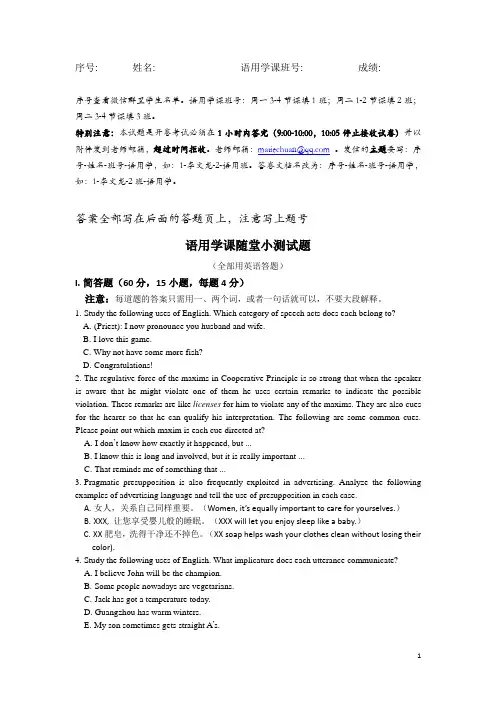
序号: 姓名: 语用学课班号: 成绩:序号查看微信群里学生名单。
语用学课班号:周一3-4节课填1班;周二1-2节课填2班;周二3-4节课填3班。
特别注意:本试题是开卷考试必须在1小时内答完(9:00-10:00,10:05停止接收试卷)并以附件发到老师邮箱,超过时间拒收。
老师邮箱:。
发信的主题要写:序号-姓名-班号-语用学,如:1-李文龙-2-语用班。
答卷文档名改为:序号-姓名-班号-语用学,如:1-李文龙-2班-语用学。
答案全部写在后面的答题页上,注意写上题号语用学课随堂小测试题(全部用英语答题)I.简答题(60分,15小题,每题4分)注意:每道题的答案只需用一、两个词,或者一句话就可以,不要大段解释。
1.Study the following uses of English. Which category of speech acts does each belong to?A.(Priest): I now pronounce you husband and wife.B.I love this game.C.Why not have some more fish?D.Congratulations!2.The regulative force of the maxims in Cooperative Principle is so strong that when the speaker is aware that he might violate one of them he uses certain remarks to indicate the possible violation. These remarks are like licenses for him to violate any of the maxims. They are also cues for the hearer so that he can qualify his interpretation. The following are some common cues. Please point out which maxim is each cue directed at?A.I don’t know how exactly it happened, but ...B.I know this is long and involved, but it is really important ...C.That reminds me of something that ...3.Pragmatic presupposition is also frequently exploited in advertising. Analyze the following examples of advertising language and tell the use of presupposition in each case.A.女人,关系自己同样重要。
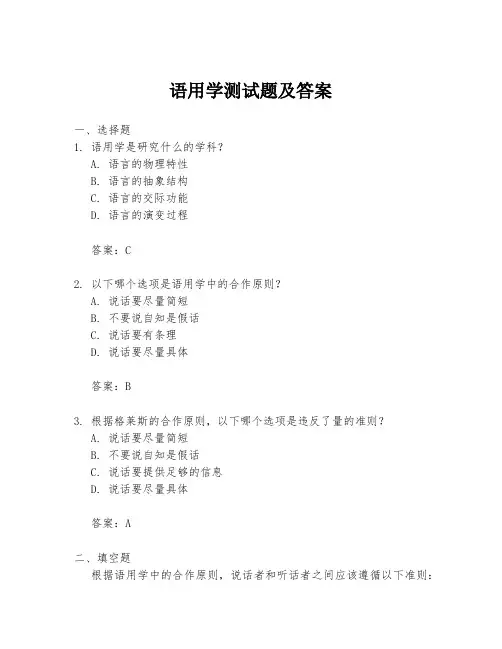
语用学测试题及答案一、选择题1. 语用学是研究什么的学科?A. 语言的物理特性B. 语言的抽象结构C. 语言的交际功能D. 语言的演变过程答案:C2. 以下哪个选项是语用学中的合作原则?A. 说话要尽量简短B. 不要说自知是假话C. 说话要有条理D. 说话要尽量具体答案:B3. 根据格莱斯的合作原则,以下哪个选项是违反了量的准则?A. 说话要尽量简短B. 不要说自知是假话C. 说话要提供足够的信息D. 说话要尽量具体答案:A二、填空题根据语用学中的合作原则,说话者和听话者之间应该遵循以下准则:1. 量的准则:说话者应提供足够的信息,但不要提供比必要更多的信息。
2. 质的准则:说话者不应说自知是假的话,不应说缺乏足够证据的话。
3. 关系准则:说话者应保持话题相关性。
4. 方式准则:说话者应避免模糊不清,避免不明确的表达。
三、简答题1. 请简述语用学中的言外行为理论。
答案:言外行为理论是语用学中的一个重要概念,它指的是说话者通过言语行为所表达的超出字面意义的信息。
言外行为通常包括直接言外行为、间接言外行为和隐喻言外行为等。
2. 举例说明如何通过语境来理解话语的隐含意义。
答案:语境在理解话语的隐含意义中起着至关重要的作用。
例如,当某人在餐厅说“这里的菜真好吃”,在不同的语境下可能有不同的隐含意义。
如果说话者刚刚品尝了一道新菜,这可能是对菜品的直接赞美;但如果餐厅的菜品普遍不佳,这句话可能隐含着讽刺的意味。
四、论述题1. 论述语用学在跨文化交际中的重要性。
答案:语用学在跨文化交际中的重要性体现在多个方面。
首先,不同文化背景的人在交际中可能有不同的语言习惯和交际准则,了解这些差异有助于避免误解和冲突。
其次,语用学可以帮助人们更好地理解言外之意,即通过语境来解读话语的隐含意义。
此外,语用学还有助于提高跨文化交际的效率和效果,通过适当的言语行为来实现交际目的。
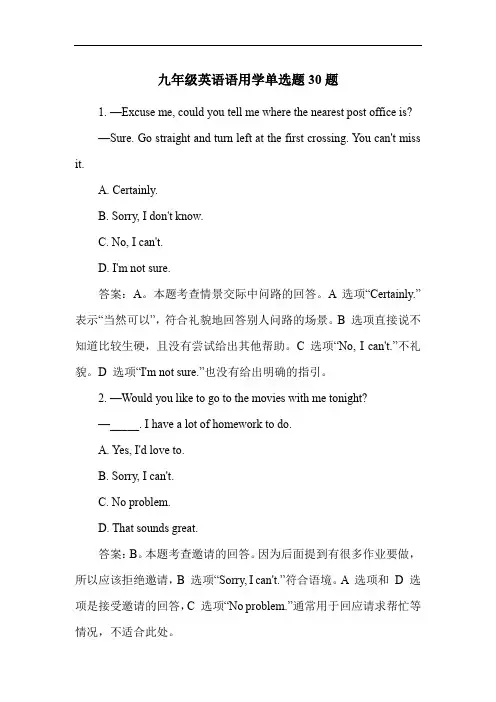
九年级英语语用学单选题30题1. —Excuse me, could you tell me where the nearest post office is?—Sure. Go straight and turn left at the first crossing. You can't miss it.A. Certainly.B. Sorry, I don't know.C. No, I can't.D. I'm not sure.答案:A。
本题考查情景交际中问路的回答。
A 选项“Certainly.”表示“当然可以”,符合礼貌地回答别人问路的场景。
B 选项直接说不知道比较生硬,且没有尝试给出其他帮助。
C 选项“No, I can't.”不礼貌。
D 选项“I'm not sure.”也没有给出明确的指引。
2. —Would you like to go to the movies with me tonight?—_____. I have a lot of homework to do.A. Yes, I'd love to.B. Sorry, I can't.C. No problem.D. That sounds great.答案:B。
本题考查邀请的回答。
因为后面提到有很多作业要做,所以应该拒绝邀请,B 选项“Sorry, I can't.”符合语境。
A 选项和D 选项是接受邀请的回答,C 选项“No problem.”通常用于回应请求帮忙等情况,不适合此处。
3. —Thank you for helping me with my English.—_____.A. It's my pleasure.B. Don't mention it.C. You're welcome.D. All of the above.答案:D。
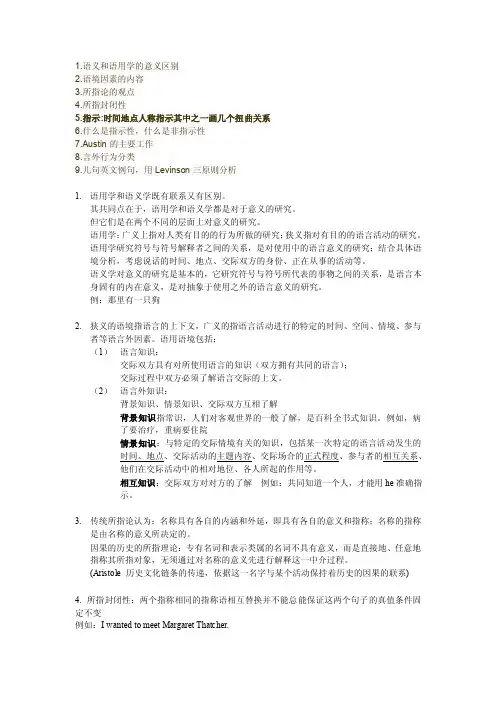
1.语义和语用学的意义区别2.语境因素的内容3.所指论的观点4.所指封闭性5.指示:时间地点人称指示其中之一画几个扭曲关系6.什么是指示性,什么是非指示性7.Austin的主要工作8.言外行为分类9.几句英文例句,用Levinson三原则分析1.语用学和语义学既有联系又有区别。
其共同点在于,语用学和语义学都是对于意义的研究。
但它们是在两个不同的层面上对意义的研究。
语用学:广义上指对人类有目的的行为所做的研究;狭义指对有目的的语言活动的研究。
语用学研究符号与符号解释者之间的关系,是对使用中的语言意义的研究;结合具体语境分析,考虑说话的时间、地点、交际双方的身份、正在从事的活动等。
语义学对意义的研究是基本的,它研究符号与符号所代表的事物之间的关系,是语言本身固有的内在意义,是对抽象于使用之外的语言意义的研究。
例:那里有一只狗2.狭义的语境指语言的上下文,广义的指语言活动进行的特定的时间、空间、情境、参与者等语言外因素。
语用语境包括:(1)语言知识:交际双方具有对所使用语言的知识(双方拥有共同的语言);交际过程中双方必须了解语言交际的上文。
(2)语言外知识:背景知识、情景知识、交际双方互相了解背景知识指常识,人们对客观世界的一般了解,是百科全书式知识。
例如,病了要治疗,重病要住院情景知识:与特定的交际情境有关的知识,包括某一次特定的语言活动发生的时间、地点、交际活动的主题内容、交际场合的正式程度、参与者的相互关系、他们在交际活动中的相对地位、各人所起的作用等。
相互知识:交际双方对对方的了解例如:共同知道一个人,才能用he准确指示。
3.传统所指论认为:名称具有各自的内涵和外延,即具有各自的意义和指称;名称的指称是由名称的意义所决定的。
因果的历史的所指理论:专有名词和表示类属的名词不具有意义,而是直接地、任意地指称其所指对象,无须通过对名称的意义先进行解释这一中介过程。
(Aristole 历史文化链条的传递,依据这一名字与某个活动保持着历史的因果的联系)4. 所指封闭性:两个指称相同的指称语相互替换并不能总能保证这两个句子的真值条件固定不变例如:I wanted to meet Margaret Thatcher.I wanted to meet the first woman Prime Minister of Great Britain.因为专有名词重名,确定性描述语有指称性和归属性两种用法等因素。
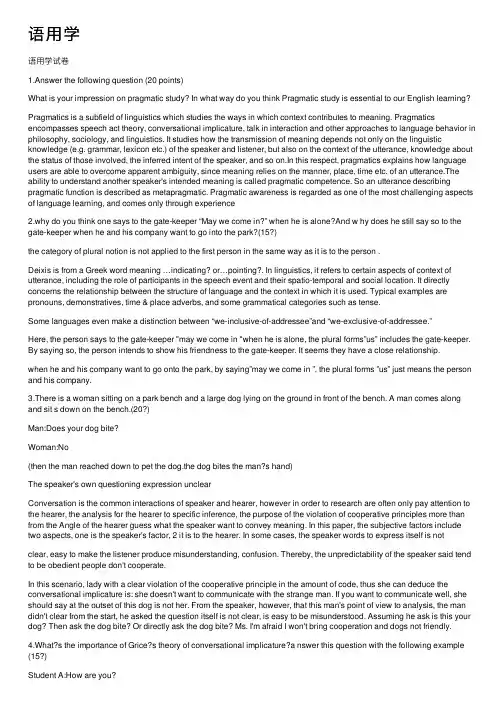
语⽤学语⽤学试卷1.Answer the following question (20 points)What is your impression on pragmatic study? In what way do you think Pragmatic study is essential to our English learning? Pragmatics is a subfield of linguistics which studies the ways in which context contributes to meaning. Pragmatics encompasses speech act theory, conversational implicature, talk in interaction and other approaches to language behavior in philosophy, sociology, and linguistics. It studies how the transmission of meaning depends not only on the linguistic knowledge (e.g. grammar, lexicon etc.) of the speaker and listener, but also on the context of the utterance, knowledge about the status of those involved, the inferred intent of the speaker, and so on.In this respect, pragmatics explains how language users are able to overcome apparent ambiguity, since meaning relies on the manner, place, time etc. of an utterance.The ability to understand another speaker's intended meaning is called pragmatic competence. So an utterance describing pragmatic function is described as metapragmatic. Pragmatic awareness is regarded as one of the most challenging aspects of language learning, and comes only through experience2.why do you think one says to the gate-keeper “May we come in?” when he is alone?And w hy does he still say so to the gate-keeper when he and his company want to go into the park?(15?)the category of plural notion is not applied to the first person in the same way as it is to the person .Deixis is from a Greek word meaning …indicating? or…pointing?. In linguistics, it refers to certain aspects of context of utterance, including the role of participants in the speech event and their spatio-temporal and social location. It directly concerns the relationship between the structure of language and the context in which it is used. Typical examples are pronouns, demonstratives, time & place adverbs, and some grammatical categories such as tense.Some languages even make a distinction between “we-inclusive-of-addressee”and “we-exclusive-of-addressee.”Here, the person says to the gate-keeper "may we come in "when he is alone, the plural forms”us” includes the gate-keeper. By saying so, the person intends to show his friendness to the gate-keeper. It seems they have a close relationship.when he and his company want to go onto the park, by saying”may we come in ”, the plural forms ”us” just means the person and his company.3.There is a woman sitting on a park bench and a large dog lying on the ground in front of the bench. A man comes along and sit s down on the bench.(20?)Man:Does your dog bite?Woman:No(then the man reached down to pet the dog.the dog bites the man?s hand)The speaker's own questioning expression unclearConversation is the common interactions of speaker and hearer, however in order to research are often only pay attention to the hearer, the analysis for the hearer to specific inference, the purpose of the violation of cooperative principles more than from the Angle of the hearer guess what the speaker want to convey meaning. In this paper, the subjective factors include two aspects, one is the speaker's factor, 2 it is to the hearer. In some cases, the speaker words to express itself is not clear, easy to make the listener produce misunderstanding, confusion. Thereby, the unpredictability of the speaker said tend to be obedient people don't cooperate.In this scenario, lady with a clear violation of the cooperative principle in the amount of code, thus she can deduce the conversational implicature is: she doesn't want to communicate with the strange man. If you want to communicate well, she should say at the outset of this dog is not her. From the speaker, however, that this man's point of view to analysis, the man didn't clear from the start, he asked the question itself is not clear, is easy to be misunderstood. Assuming he ask is this your dog? Then ask the dog bite? Or directly ask the dog bite? Ms. I'm afraid I won't bring cooperation and dogs not friendly.4.What?s the importance of Grice?s theory of conversational implicature?a nswer this question with the following example (15?)Student A:How are you?Student B:I?m dead.The importance of the theory of conversational implicature in pragmatics is due to various sources or contributions.1.the theory of conversational implicature may provide come significant function explanation for linguistic facts.2.it provides some explicit account of how it is possible to mean more than what is actually “said”, or more than what is literally expressed.3.it may help to simplify the content of semantic descriptions.4.it is essential if various basic facts about language are to be accounted for properly.5. it may offer an insight into the rhetorical use of language.The Cooperative Principle has four categories of maxims as follows:1. Quantity2.Quality3.Relation4.MannerIt is important to recognize these maxims as unstated assumptions we have in conversations. In this case, it violates the Quality of CP. Quality: Try to make your contribution one that is true.(1) Do not say what you believe to be false.(2) Do not say that for which you lack adequate evidence.We can see the sentence “I?m dead” is not true, so it violates the maxim of quality in CP and products implicature.5.Xiao:(look around)(20’)Grocer:⽼师吃什么?(what would you like to have,teacher?)Xiao:西⽠多少钱⼀⽄?(How much is water melon?)Grocer:⼀块⼆(one yuan and twenty)Xiao:⼀块⼆?很贵的(one yuan and twenty?very expensive)Grocer:哦,我们进来就⼀块⼀,⼀天挣不了⼏个钱,你要我给你便宜⼀⽑Grocer:好,来⼀个。
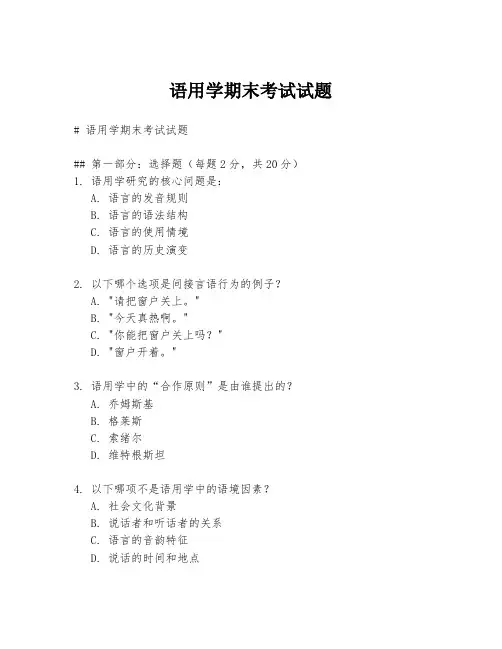
语用学期末考试试题# 语用学期末考试试题## 第一部分:选择题(每题2分,共20分)1. 语用学研究的核心问题是:A. 语言的发音规则B. 语言的语法结构C. 语言的使用情境D. 语言的历史演变2. 以下哪个选项是间接言语行为的例子?A. "请把窗户关上。
"B. "今天真热啊。
"C. "你能把窗户关上吗?"D. "窗户开着。
"3. 语用学中的“合作原则”是由谁提出的?A. 乔姆斯基B. 格莱斯C. 索绪尔D. 维特根斯坦4. 以下哪项不是语用学中的语境因素?A. 社会文化背景B. 说话者和听话者的关系C. 语言的音韵特征D. 说话的时间和地点5. 语用学中的“礼貌原则”包括哪些子原则?A. 量准则、质准则、关系准则、方式准则B. 量准则、质准则、方式准则、目的准则C. 质准则、关系准则、方式准则、目的准则D. 量准则、关系准则、方式准则、目的准则## 第二部分:简答题(每题10分,共30分)1. 解释“言语行为”理论中的“言内行为”、“言外行为”和“言后行为”。
2. 描述“隐喻”在语用学中的作用及其对语言理解的影响。
3. 阐述“语境”在语言交流中的重要性,并举例说明。
## 第三部分:论述题(每题25分,共50分)1. 论述“预设”在语言交流中的作用及其可能引起的误解。
2. 分析“指示语”在不同语境下的变化,并讨论其对交流的影响。
## 第四部分:案例分析题(共30分)阅读以下对话,并分析其中涉及的语用学概念:- A: “你昨天去图书馆了吗?”- B: “如果我去了,我就不会问你借书了。
”请从语用学的角度,分析B的回答中隐含的意思,并讨论这种交流方式在日常生活中的应用。
请注意,以上试题仅为示例,实际考试内容和形式可能有所不同。
考生应根据具体的教学大纲和课程内容进行复习准备。
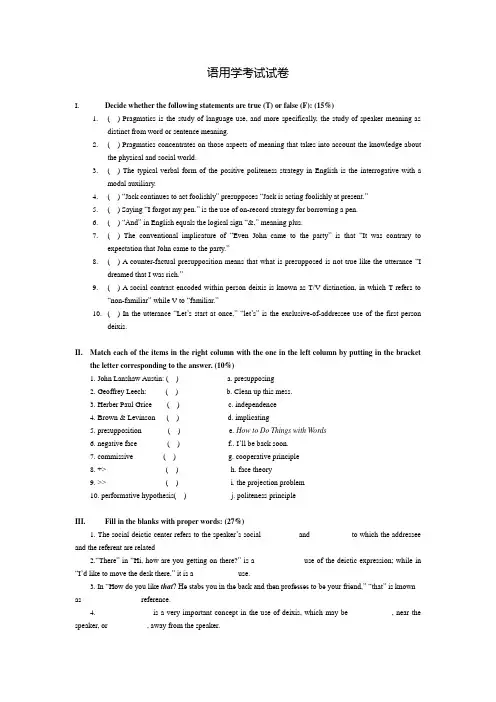
语用学考试试卷I.Decide whether the following statements are true (T) or false (F): (15%)1.( ) Pragmatics is the study of language use, and more specifically, the study of speaker meaning asdistinct from word or sentence meaning.2.( ) Pragmatics concentrates on those aspects of meaning that takes into account the knowledge aboutthe physical and social world.3.( ) The typical verbal form of the positive politeness strategy in English is the interrogative with amodal auxiliary.4.( ) “Jack continues to act foolishly” presupposes “Jack is acting foolishly at present.”5.( ) Saying “I forgot my pen.” is the use of on-record strategy for borrowing a pen.6.( ) “And” in English equals the logical sign “&,” meaning plus.7.( ) The conventional implicature of “Even John came to the party”is that “It was contrary toexpectation that John came to the party.”8.( ) A counter-factual presupposition means that what is presupposed is not true like the utterance “Idreamed that I was rich.”9.( ) A social contrast encoded within person deixis is known as T/V distinction, in which T refers to“non-familiar” while V to “familiar.”10.( ) In the utterance “Let’s start at once,”“let’s” is the exclusive-of-addressee use of the first persondeixis.II. Match each of the items in the right column with the one in the left column by putting in the bracket the letter corresponding to the answer. (10%)1. John Lanshaw Austin: ( ) a. presupposing2. Geoffrey Leech: ( ) b. Clean up this mess.3. Herber Paul Grice ( ) c. independence4. Brown & Levinson ( ) d. implicating5. presupposition ( ) e. How to Do Things with Words6. negative face ( ) f.. I’ll be back soon.7. commissive ( ) g. cooperative principle8. +> ( ) h. face theory9. >> ( ) i. the projection problem10. performative hypothesis( ) j. politeness principleIII.Fill in the blanks with proper words: (27%)1. The social deictic center refers to the speaker’s social _________ and __________ to which the addressee and the referent are related2.“There” in “Hi, how are you getting on there?” is a ____________ use of the deictic expression; while in “I’d like to move the desk there,” it is a ___________ use.3. In “How do you like that? He stabs you in the back and then professes to be your friend,”“that” is known as _______________ reference.4. ______________ is a very important concept in the use of deixis, which may be ___________, near the speaker, or __________, away from the speaker.5. A conversational implicature is generated when one or more of the maxims of cooperative principle is ______________ with the hearer’s ______________.6. The hyperbole in “She’s the most beautiful girl in the world” can be interpreted as being produced through the violation of the maxim of ______________.7. The blessing expression “Happy new year!” is an example of __________ deixis.8. According to politeness theory, the more ____________ the linguistic form is, the higher degree of politeness it has when used to make a request.9. The locutionary act of an utterance is concerned with the basic act of its ____________ form; while the illocutionary act with its ____________. and the perlocutionary act with its_____________.10. The final phrase “I guess”in “It will clear up tomorrow, I guess.”is called a __________ device that exemplifies the speaker’s observation of the maxim of ___________.11. In saying “I don’t know if this is important, but some of the files are missing,” the speaker is observing the maxim of ________________.12. According to Halliday, language plays three functions, namely ______________ function, _____________ function, and ______________ function,13. A simple utterance like “I’m tired” may have different pragmatic meanings in different contexts. Write out the sentence semantic meaning,two of its possible pragmatic meanings and the corresponding contexts they are in.the semantic meaning: ____________________________________________pragmatic meaning 1: _____________________________________________(the relevant context):_____________________________________________pragmatic meaning 2: _____________________________________________(the relevant context):_____________________________________________IV.Briefly answer TWO of the following questions (around 50-60 words for each) Write your answer on the other side of the paper. (Attention: Indicate your choices among the questions by writing their corresponding letters at the beginning of your answers.). (48%)a)It is strongly believed that background knowledge, to which culture is closely related culture, plays avery important role in communication. What implications do you think this belief has for interculturalcommunication and foreign/ second language teaching?b)In what way is deixis or speech act theory or conversational implicature theory or presuppositiontheory, an important aspect of pragmatic study? (Give at least one example to illustrate your discussion) (15%)c)One of the properties of politeness is gradation. Do you think the more polite an utterance is, the betterit is? Why (not)? (15%)d)Point out TWO of the five features of conversational implicature discussed in class and use examplesto illustrate the features.Answer KeyI. 1. T 2. T 3. F 4. F 5. F 6. F 7. T 8. F 9. F 10. FII. 1. e 2. j 3. g 4. h 5. I 6. c 7. f 8. d 9. a 10. bIII. 1. status, rank 2. symbolic, gestural 3.cataphoric 4. distance, proximal, distal5. violated, knowledge6. quality7. social8. indirect9. linguistic, force, effect10. hedging, quality 11. relation 12. interpersonal, ideational, textual 13. (omitted)IV. (omitted)。
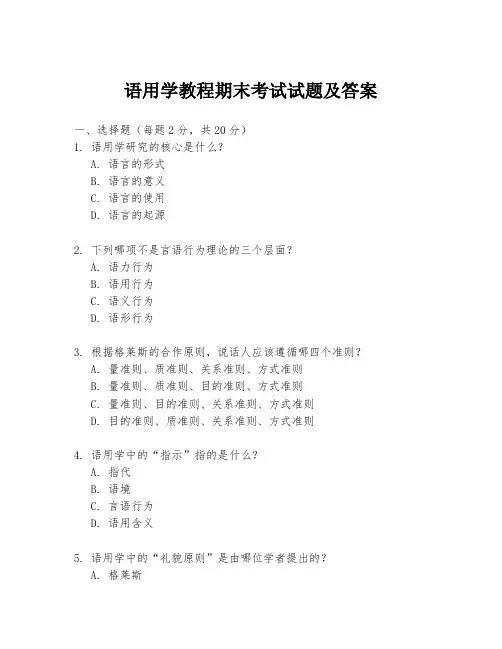
语用学教程期末考试试题及答案一、选择题(每题2分,共20分)1. 语用学研究的核心是什么?A. 语言的形式B. 语言的意义C. 语言的使用D. 语言的起源2. 下列哪项不是言语行为理论的三个层面?A. 语力行为B. 语用行为C. 语义行为D. 语形行为3. 根据格莱斯的合作原则,说话人应该遵循哪四个准则?A. 量准则、质准则、关系准则、方式准则B. 量准则、质准则、目的准则、方式准则C. 量准则、目的准则、关系准则、方式准则D. 目的准则、质准则、关系准则、方式准则4. 语用学中的“指示”指的是什么?A. 指代B. 语境C. 言语行为D. 语用含义5. 语用学中的“礼貌原则”是由哪位学者提出的?A. 格莱斯B. 布朗和莱文森C. 奥斯汀D. 赛尔...(此处省略其他选择题)二、简答题(每题10分,共30分)1. 简述语用学中的“隐喻”和“转喻”的区别。
2. 描述格莱斯的合作原则中的“量准则”。
3. 解释“言语行为”和“言语行为理论”的基本概念。
三、论述题(每题25分,共50分)1. 论述语用学在跨文化交际中的应用。
2. 分析并讨论“语境”在语用学中的重要性。
答案一、选择题1. C2. D3. A4. B5. B...(此处省略其他选择题答案)二、简答题1. 隐喻是一种通过将一个概念域映射到另一个概念域来表达意义的语言现象,而转喻则是通过将一个概念域中的某个元素与另一个概念域中的元素相联系来表达意义。
2. 量准则要求说话人在交际中提供足够的信息,既不多也不少,以满足交际的需要。
3. 言语行为是指说话人通过言语表达的意图,而言语行为理论是奥斯汀提出的,它将言语行为分为三个层面:语力行为、语义行为和语形行为。
三、论述题1. 语用学在跨文化交际中的应用主要体现在理解和解释不同文化背景下的言语行为,帮助人们避免误解和冲突,促进有效沟通。
2. 语境在语用学中的重要性体现在它对言语行为的理解和解释中起着决定性作用。
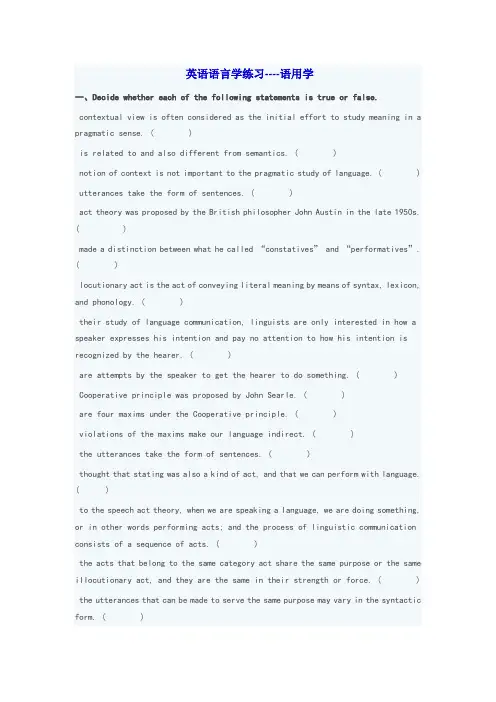
英语语言学练习----语用学一、Decide whether each of the following statements is true or false.contextual view is often considered as the initial effort to study meaning in a pragmatic sense. ( )is related to and also different from semantics. ( )notion of context is not important to the pragmatic study of language. ( ) utterances take the form of sentences. ( )act theory was proposed by the British philosopher John Austin in the late 1950s. ( )made a distinction between what he called “constatives” and “performatives”. ( )locutionary act is the act of conveying literal meaning by means of syntax, lexicon, and phonology. ( )their study of language communication, linguists are only interested in how a speaker expresses his intention and pay no attention to how his intention is recognized by the hearer. ( )are attempts by the speaker to get the hearer to do something. ( )Cooperative principle was proposed by John Searle. ( )are four maxims under the Cooperative principle. ( )violations of the maxims make our language indirect. ( )the utterances take the form of sentences. ( )thought that stating was also a kind of act, and that we can perform with language. ( )to the speech act theory, when we are speaking a language, we are doing something, or in other words performing acts; and the process of linguistic communication consists of a sequence of acts. ( )the acts that belong to the same category act share the same purpose or the same illocutionary act, and they are the same in their strength or force. ( ) the utterances that can be made to serve the same purpose may vary in the syntactic form. ( )participants nearly always observe the CP and the maxims of the CP. ( ) sentence is grammatical concept, and the meaning of a sentence is often studied as the abstract intrinsic property of the sentence itself in terms of a predication. ( )is based on sentence meaning, it is the realization of the abstract meaning of a sentence in a real situation of communication or simply in a context. ( ) the process of communication is essentially a process of conveying meaning in a certain context, pragmatics can also be regarded as a kind of meaning study. ( )linguists found that it would be impossible to give an adequate description of meaning if the context of language use was left considered.essentially distinguishes semantics and pragmatics is whether in the study of meaning the context of use is considered. ( )the shared knowledge both by the speaker and the hearer, linguistic communication would not be possible, and without considering such knowledge, linguistic communication cannot be satisfactorily accounted for in a semantic sense. ( ) perlocutionary act is the act of expressing the speaker’s intention. () to Paul Grice’s idea, in making conversation, the participants must first of all be willing to cooperate, otherwise, it would not be possible for them to carry on the talk. ( )illocutionary act is the consequence of or the change brought about by the utterance.【Keys】:1. T2. T11. T 16. F 17. T21. T 26. T 27. F二、Fill each of following blanks with one word which begins with the letter given.1. The shared knowledge which constitutes context is of two types; the knowledge of the l________ they use, and the knowledge about the w_______, including the general knowledge about the world and specific knowledge about the situation in which linguistic communication is taking place.2. If we think of a sentence as what people actually utter in the course of communication, it becomes an u________, and it should be considered in the situation in which it is actually used.3. The idea of Paul Grice is that in making conversation, the participants must first of all be willing to c_______, otherwise, it would be impossible for them to carry on the talk. The general principle is called the c________ p_________, abbreviated as CP.4. There are four maxims under the CP: the maxim of quantity, the maxim of q_________, the maxim of relation and the maxim of m____________.5. The maxim of relation requires that what the conversation participants say must be r__________.6. As the process of communication is essentially a process of conveying meaning in a certain context, p__________ can be regarded as a kind of meaning study.7. If c___________ is not considered, the study of meaning is restricted to the area of traditional semantics.8. The meaning of an u__________ is concrete and context-dependent.9. An i___________ act is the act of expressing the speaker’s intention.10. According to Seale, s__________acts fall into five general categories.11. C__________ are those speech acts whose point is to commit the speaker to some future course of action.12. To ask someone to pass a book is obviously a d__________.13. According to Paul Grice, in making c__________ the participants must first of all be willing to cooperate.14. Most of the violations of the four maxims give rise to c___________ implicatures.15. The significance of Grice’s c___________ principle lies in that it explains how it is possible for the speaker to convey more than is literally said.【Keys】:1. language, word2. utterance3. cooperate, Cooperative Principle4. quality, mannar5.relevant6. pragmatics7. context8. utterance9. illocutionary 10. speech 11.Commissive 12. dirextive 13. conversation 14. conversational15. Cooperative三、There are four choices following each statement. Mark the choice that can best complete the statement.1. __________ resulted mainly from the eapansion of the study of linguistics, especially that of semantics.A. PragmaticsB. PragmatismC. PhonologyD. Practicalism2. Once the notion of _________ was taken into consideration, semantics spiiled into pragmatics.A. meaningB. contextC. formD. content3. If a sentence is regarded as what people actually utter in the course of communication, it becomes _______.A. a sentenceB. an actC. a unitD. an utterance4. A ___________ analysis of an utterance will reveal what the speaker intends to do with it.A. semanticB. syntacticC. pragmaticD. grammatical5. _______ act theory is an important theory in the pragmatic study of language.A. SpeakingB. SpeechC. SoundD. Spoken6. ______ act is the act performed by or resulting from saying something.A. A locutionaryB. An illocutionaryC. A perlocutionaryD. A speech7. One of the contributions Searle has made is his classification of __________ acts.A. locutionaryB. illocutionaryC. perlocutionaryD. speech8. The illocutionary point of __________ is to express the psychological state specified in the utterance.A. directivesB. commisivesC. expressivesD. declarations9. All the utterance that can be made to serve the same purpose may vary in their _________ form.A. syntacticB. semanticC. grammaticalD. pragmatic10. The cooperative Principle is proposed by ________.A. John SearleB. John AustinC. Paul GriceD. John Lyons11. Linguists found that it would be impossible to give an adequate description of meaning if the ________ of language use was left unconsidered.A. brevityB. contextC. accuracyD. none of the above12. Of the three speech acts, linguistic are most interested in the _________.A. locutionary actB. perlocutionary actC. illocutionary actD. none of the above13. The maxim of quantity requires: ___________.A. make your contribution ad informative as required.B. Do not make contribution more informative than is required.C. Do not say that for which you lack adequate evidence.D. Both A and B.14. The maxim of quality requireds: do not say what you believe to be ________.A. falseB. trueC. briefD. orderly15. Most of the violations of the maxims of the CP give rise to _______.A. utterance meaningB. speech act theoryC. conversational implicaturesD. all of the above.16. The significance of Grice’s CP lies in that it explains how it is possible for the speaker to convey _________ is literally said.A. more thanB. less thanC. the same asD. none of the above.【Keys】:1. A2. B3. D4. C5. B6. C7.B 8.C 9. A 10. C 11. B 12. C 13.D 14. A 15. C 16. A四、Define the following terms.1. context2. utterance meaning3. locutionary act4. illocutionary act5. perlocutionary act【Keys】:1. Context is regarded as constituted by all kinds of knowledge assumed to be shared by the speaker and the hearer.2. Utterance meaning is the realization of the abstract meaning of a sentence ina real situation of communication, or simply in a context; it is concrete and dependent on the context.3. A locutionary act is the act of uttering words, phrases, and clauses. It is the act of conveying literal meaning by means of syntax, lexicon and phonology.4. An ill ocutionary act is the act of expressing the speaker’s intention; it is the act performed in saying something.5. A perlocuionary act is the act performed or resulting from saying something; it is the consequence of, or resulting saying something.。
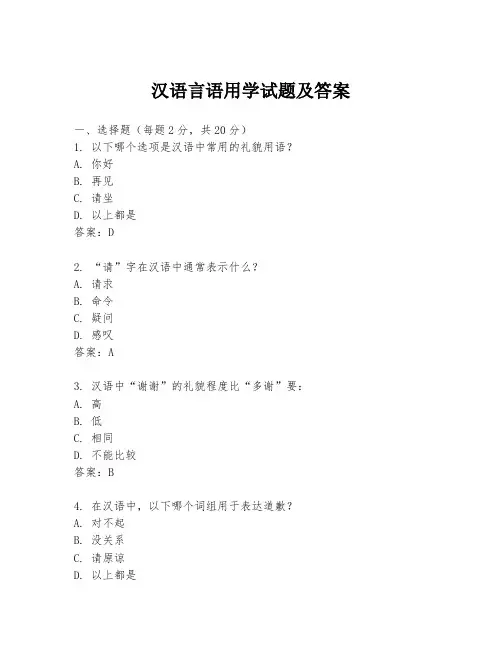
汉语言语用学试题及答案一、选择题(每题2分,共20分)1. 以下哪个选项是汉语中常用的礼貌用语?A. 你好B. 再见C. 请坐D. 以上都是答案:D2. “请”字在汉语中通常表示什么?A. 请求B. 命令C. 疑问D. 感叹答案:A3. 汉语中“谢谢”的礼貌程度比“多谢”要:A. 高B. 低C. 相同D. 不能比较答案:B4. 在汉语中,以下哪个词组用于表达道歉?A. 对不起B. 没关系C. 请原谅D. 以上都是5. 汉语中“请稍等”的意思是:A. 请等待B. 请离开C. 请快点D. 请坐下答案:A6. 汉语中“打扰一下”通常用于:A. 表示不满B. 表示请求C. 表示感谢D. 表示道歉答案:B7. 在汉语中,“请问”一词通常用于:A. 开始提问B. 结束提问C. 表示命令D. 表示拒绝答案:A8. 汉语中“请慢用”通常用于:A. 用餐时B. 工作时C. 学习时D. 睡觉时答案:A9. 在汉语中,“请多指教”通常用于:B. 工作时C. 用餐时D. 睡觉时答案:B10. 汉语中“请稍候”的意思是:A. 请等待B. 请离开C. 请快点D. 请坐下答案:A二、填空题(每题2分,共20分)1. 汉语中表示“请慢走”的礼貌用语是“________”。
答案:请慢走2. 汉语中表示“请稍等”的礼貌用语是“________”。
答案:请稍等3. 在汉语中,当需要别人让路时,可以说“________”。
答案:借过4. 汉语中表示“请坐”的礼貌用语是“________”。
答案:请坐5. 汉语中表示“请稍候”的礼貌用语是“________”。
答案:请稍候6. 汉语中表示“请多指教”的礼貌用语是“________”。
答案:请多指教7. 在汉语中,当需要别人帮助时,可以说“________”。
答案:请帮忙8. 汉语中表示“请原谅”的礼貌用语是“________”。
答案:请原谅9. 在汉语中,当需要别人让座时,可以说“________”。

语用学期末考试试题及答案一、选择题(每题2分,共20分)1. 语用学研究的核心是什么?A. 语言的语音学B. 语言的语法结构C. 语言的交际功能D. 语言的词汇学2. 以下哪个概念不属于语用学研究范畴?A. 语境B. 语义C. 语用失误D. 语音3. 语用学中的“合作原则”是由哪位学者提出的?A. 乔姆斯基B. 格莱斯C. 索绪尔D. 奥斯汀4. 以下哪个选项不是语用学中的言语行为?A. 陈述B. 命令C. 询问D. 描述5. 语用学中的“隐喻”属于哪种言语行为?A. 陈述B. 命令C. 询问D. 描述6. 以下哪个选项是语用学中的“言语行为”理论?A. 乔姆斯基的生成语法B. 奥斯汀的言语行为理论C. 索绪尔的结构主义D. 格莱斯的合作原则7. 语用学中的“礼貌原则”是由哪位学者提出的?A. 格莱斯B. 奥斯汀C. 索绪尔D. 乔姆斯基8. 语用学中的“语境”是指什么?A. 语言使用的物理环境B. 语言使用的文化环境C. 语言使用的社会环境D. 语言使用的所有环境因素9. 以下哪个选项不是语用学中的“语境”因素?A. 参与者B. 地点C. 时间D. 语法结构10. 语用学中的“预设”是指什么?A. 语言使用的前提条件B. 语言使用的逻辑结构C. 语言使用的语境因素D. 语言使用的语义内容二、简答题(每题10分,共30分)1. 简述语用学中的“合作原则”。
2. 举例说明“言语行为”理论中的“言外行为”。
3. 解释“礼貌原则”在交际中的作用。
三、论述题(每题25分,共50分)1. 论述语用学中的“语境”对语言理解和使用的影响。
2. 分析“隐喻”在交际中的功能及其在广告中的应用。
参考答案一、选择题1-5 C D B B D6-10 B D D C A二、简答题1. 合作原则是格莱斯提出的,它认为在交际中,参与者会遵循一系列原则以确保交际的有效性。
这些原则包括数量原则、质量原则、关联原则和方式原则。
2. 言外行为是奥斯汀言语行为理论中的概念,指的是言语行为中除直接表达的意义之外,还隐含的其他意义。
语用学期末考试题及答案一、选择题(每题2分,共20分)1. 语用学研究的核心是什么?A. 语言的形式B. 语言的功能C. 语言的规则D. 语言的演变答案:B2. 以下哪个选项不属于言语行为理论中的三个层次?A. 言内行为B. 言外行为C. 言后行为D. 言前行为答案:D3. 在语用学中,隐喻属于哪种言语行为?A. 陈述行为B. 指令行为C. 承诺行为D. 描述行为答案:A4. 以下哪个概念不是由格莱斯提出的合作原则?A. 质量准则B. 量准则C. 关联准则D. 礼貌原则答案:D5. 语用学中的“语境”指的是什么?A. 说话的地点B. 说话的时间C. 说话的背景D. 所有上述选项答案:D6. 以下哪个选项是语用学中的“预设”?A. 说话者和听话者共享的知识B. 说话者希望听话者接受的信息C. 说话者在言语中隐含的信息D. 听话者对言语的理解答案:C7. 以下哪个概念是由布朗和莱文森提出的?A. 合作原则B. 礼貌原则C. 语境原则D. 预设原则答案:B8. 以下哪个选项不是语用学中的推理类型?A. 归纳推理B. 演绎推理C. 类比推理D. 逻辑推理答案:D9. 语用学中的“指示”指的是什么?A. 指代说话者或听话者B. 指代时间和地点C. 指代言语行为D. 指代所有上述选项答案:B10. 以下哪个选项是语用学中的“言语行为”?A. 说话B. 写文章C. 完成一项任务D. 所有上述选项答案:D二、简答题(每题10分,共30分)1. 简述语用学中的“言外行为”是什么,并给出一个例子。
答案:言外行为指的是说话者通过言语表达的意图或目的,而不仅仅是言语的字面意义。
例如,当某人说“你能帮我关一下窗户吗?”时,其言外行为是请求对方关窗户。
2. 解释“礼貌原则”及其在日常生活中的应用。
答案:礼貌原则是由布朗和莱文森提出的,它指导人们在交流中如何以礼貌的方式表达自己,避免冒犯他人。
在日常生活中,人们通过使用委婉语、避免直接否定、使用礼貌用语等方式来遵循礼貌原则。
本次考试共四种题型:填空题、名词解释、简答题、应用题填空题:(举例如:)(每空1分,共10分)1.语用学源于哲学家对语言的探索。
“语用学”这一术语是由美国哲学家(莫里斯)于1938年首先提出的。
2.1977年,(《语用学杂志》)在荷兰正式出版发行,“语用学成为语言学的一门独立新兴学科”最终得到认可。
名词解释:(每个4分,共20分)语用学语境指示词语隐性施为句优选结构预示序列会话含义直接言语行为间接言语行为分支系列预设触发语话轮话轮对1.语用学定义:语用学研究在不同语境中话语意义的恰当表达和准确理解,寻找并确立使话语意义得以恰当表达和准确理解的基木原则和准则。
2.语境定义:语境是人们运用自然语言进行交际的言语环境。
这个定义指明:a我们研宄的是运用自然语言进行的言语交际;b言语交际有成效地进行(即说话人恰当地表达话语意义和听话人准确地理解话语意义)必须依赖言语环境。
因此我们认为,“语境”是指言语环境,而非语言环境。
3.指示系统:人们典型的交际方式是面对面交谈,即由一人对一人或由一人对多人,通过说一听的方式进行交谈。
在面对面的交谈中,指示系统,一般地说,是以自我(说话人)为中心组织起来的。
4. 隐性施为句:人们在言语交际中实际上更经常使用一些不那么明确、不那么特定的语言手段來实施某种行为。
5. 优选结构:相邻对中所有可能跟始发语配对的应答语并不具有同等地位,有一组优选结构在起作用,即各种可能的应答语中至少有一类是“合意的”(即听话人的应答能满足说话人发话的期待),有一类是“不合意的”(即听话人的应答不是说话人所期待的)。
合意的应答语是无标记的一一在结构上以较简单的一轮话出现。
而不合意的应答语是有标记的一一在结构上有各种复杂的形式。
6.预示序列:说话人在以言行事之前用以探听虚实的一类话语。
说话人使用这类话语的主要动机是考察有无向听话人实施某一言语行为的可能性,即说话人实施某一言语行为能否从听话人那里得到“期待的”反应。
语用学期末考试题及答案一、选择题(每题2分,共20分)1. 语用学研究的核心是什么?A. 语言的语法结构B. 语言的发音规则C. 语言的使用和理解D. 语言的历史演变答案:C2. 以下哪项不是语境对语言理解的影响因素?A. 社会文化背景B. 物理环境C. 个人情感状态D. 语言的词序答案:D3. 语用学中的“合作原则”是由哪位学者提出的?A. 乔姆斯基B. 奥斯汀C. 格赖斯D. 索绪尔答案:C4. 在语用学中,“言外之意”通常指的是什么?A. 语言的字面意思B. 语言的隐含意义C. 语言的修辞手法D. 语言的语法结构答案:B5. 以下哪个选项不是语用学中的言语行为?A. 陈述B. 命令C. 询问D. 描述答案:D6. 语用学中的“礼貌原则”是由哪位学者提出的?A. 布朗和莱文森B. 格赖斯C. 奥斯汀D. 索绪尔答案:A7. 在语用学中,如何理解“语境”这一概念?A. 仅指语言使用的物理环境B. 仅指语言使用的社交环境C. 包括语言使用的物理环境和社交环境D. 仅指语言使用的文化环境答案:C8. 以下哪项不是语用学中的话语分析方法?A. 话语连贯性分析B. 话语结构分析C. 话语主题分析D. 语法结构分析答案:D9. 语用学中的“指示语”主要指的是什么?A. 指示时间的词语B. 指示地点的词语C. 指示说话人和听话人关系的词语D. 指示说话人和听话人身份的词语答案:C10. 在语用学中,如何理解“隐喻”这一概念?A. 一种修辞手法B. 一种语言错误C. 一种逻辑推理D. 一种语法结构答案:A二、简答题(每题5分,共30分)1. 简述语用学与语义学的主要区别。
答:语用学主要研究语言的使用和理解,关注语境对语言的影响,而语义学则关注语言的意义和结构。
2. 描述格赖斯的“合作原则”包含哪些准则。
答:合作原则包含四个准则:数量准则、质量准则、关联准则和方式准则。
3. 解释“礼貌原则”在交际中的作用。
答:礼貌原则指导人们在交际中遵循一定的规范,以减少冲突,维护和谐的社交关系。
语言运用期末考试试卷第一部分:选择题1. 下列单词中,哪一个是正确的写法?a) 電話 b) 电话 c) 通讯 d) 通訊2. 他______洗澡,突然接到了一通重要电话。
a) 正在 b) 将要 c) 曾经 d) 经常3. 请问今天的日期是几号?a) 贰零壹玖年五月廿八日 b) 二〇一九年五月二十八日 c) 二○一九年五月廿八日 d) 贰零壹九年伍月廿捌日4. 下列哪个句子语法错误?a) 我们都很喜欢这个新老师。
b) 每天早上我骑自行车上学。
c) 她的新发型使她看起来更年轻。
d) 我越努力,我得到的回报就越大。
5. 以下哪个选项不是形容词?a) 高兴 b) 自行车 c) 蓝色 d) 漂亮6. 下列哪个短语意味着放弃?a) 丢三落四 b) 咎由自取 c) 来日方长 d) 刮目相看7. 找出下列句子中的主语:a) 他和我一起去看电影。
b) 前天是她的生日。
c) 桌子上有一本书。
d) 每个人都应该尊重别人的意见。
8. 下列哪个选项是正确的反义词?a) 冷 b) 悲伤 c) 善良 d) 小心9. 请根据下列汉字选择正确的注音:電 a) dian4 b) tian2 c) dian2 d) tian410. 下列哪个句子中的语气最为委婉?a) 请你安静一下。
b) 你可以稍微放慢一点速度吗?c) 你怎么可以这样对我说话!d) 把这件事情办好,否则就别回来了!第二部分:填空题请根据句子的语境,选择恰当的词语填入空白处。
1. 我 ________ 发现,那个问题的解决办法很简单。
2. 他的演讲 ________ 引起了听众的兴趣。
3. 这个电视节目 ________ 了很多观众,深受欢迎。
4. 她的自信和才华让人 ________。
5. 这个项目 ________ 了很多年来的经验和技术。
第三部分:阅读理解阅读下面的短文,并根据短文内容回答问题。
[Text]根据美国心理学家的研究,人们表达愤怒时会产生更强烈的记忆。
语用学复习题语用学复习题语用学是研究语言使用的学科,它关注的是语言在特定语境中的意义和效果。
通过对语言使用的研究,我们可以更好地理解人们的交际行为,进而提高自己的语言运用能力。
下面是一些语用学的复习题,希望能够帮助大家回顾和巩固相关知识。
一、选择题1. 下列句子中,哪个是直接言语行为?A. "你能帮我一下吗?"B. "你真聪明!"C. "明天见!"D. "你觉得这个问题怎么解决?"2. 下列句子中,哪个是间接言语行为?A. "请把窗户关上。
"B. "我想请你帮个忙。
"C. "你真是个好人!"D. "请问一下,这个地方怎么走?"3. 下列句子中,哪个是言外之意?A. "我好饿,想吃点东西。
"B. "你能帮我一个忙吗?"C. "你看起来很累,需要休息一下。
"D. "你真是个天才!"4. 下列句子中,哪个是言下之意?A. "我喜欢你的新发型。
"B. "你能不能别这么吵?"C. "你真是个好朋友!"D. "你觉得这个问题怎么解决?"5. 下列句子中,哪个是直接表示言外之意?A. "我好饿,想吃点东西。
"B. "你真是个聪明的孩子!"C. "你看起来很累,需要休息一下。
"D. "你觉得这个问题应该怎么解决?"二、判断题1. 言语行为是指通过语言表达出来的行为。
2. 言语行为可以分为直接言语行为和间接言语行为。
3. 言外之意是指通过语言表达出来的真实意图。
4. 言下之意是指通过语言表达出来的含蓄意味。
5. 言外之意和言下之意在语用学中是同一个概念。
1.Pragmatics can be defined in various ways. A general definition is that it is thestudy of how speakers of a language use sentences to effect successful communication.As the process of communication is essentially a process of conveying meaning in a certain context, pragmatics can also be defined as the study of language in use.2.Pragmatics vs. SemanticsThe essential distinguish between semantics and pragmatics is whether in the study of meaning the context of use is considered. If it is not considered, the study is restricted to the area of traditional semantics; if it is considered, the study is being carried out in the area of pragmatics.3. Being essential to pragmatics, context is generally considered as constituted by theknowledge shared by the speaker and the hearer. There’re two types of shared knowledge: the knowledge of the language they use, and the knowledge about the world, including the general knowledge about the world and the specific knowledge about the situation in which linguistic communication is taking place. Without such knowledge, linguistic communication would not be possible, and without considering such knowledge, linguistic communication cannot be satisfactorily accounted for in a pragmatic sense.4.Sentence is a grammatical concept, its meaning is often studied as the abstract,intrinsic property of the sentence itself in terms of a predication. Utterance is based on sentence meaning; it is the realization of the abstract meaning of a sentence in a real situation of communication, or simply in a context.5. Summary1) Language meaning can be analyzed at several levels.2) Semantics concentrates on the meaning that comes from linguistic knowledge, while pragmatics concentrates on those aspects of meaning that cannot be predicted by linguistic knowledge alone and takes into account our knowledge about the physical and social world.3) The focus of pragmatic analysis is on the meaning of speakers’ utterances rather than on the meaning of words or sentences.4) Utterances need not consist of complete sentences. Each utterance is a unique physical event created at a particular point in time for a particular communicative purpose.6. Entailment:a relationship between sentences that forms the basis for some of these inferences(推断).7.You would need other, non-。
linguistic, information about Tom’s mother and theparticular cat referred to here. These are sometimes labeled as Synthetic Sentence. Synthetically True/ False8.The term paraphrase is used in semantics when there is a relationship of mutual entailment between two sentences.9.Summary:1)All sentences have a number of entailments,——other sentences which are automatically true if the original sentence is true, then ‘other sentences’ are the entailments of ‘the original sentence’.2) Entailments are inferences that can be drawn solely from our knowledge about the semantic relationships in a language.3) This knowledge allow us to communicate much more than we actually ‘say’.10.Declarative sentences typically function as ‘statement’.Such as you ran away with you the Subject and ran the VerbIn imperative sentences, which typically function as ‘commands’, there is no subject present although it is ‘understood’ as you as in Run away!Interrogative sentences typically fu nction as ‘questions’.11.Analyzing the relation of entailment1)If X is true, Y is necessarily true2) If X is false, Y may be true or false3) If Y is true, X may be true or false4) If Y is false, X is false12.For presupposition, the key point is that if Xpresupposes Y, Y is a presupposition of X1) If X is true, Y must be true2) If X is false, Y is still true3) If Y is true, X is either true or false4) If Y is false, no truth value can be said about X13.Notice that possessives lead to a particularly strong Presupposition about the existence of the choc olate cake, and in addition lead to the presupposition that ‘Annie has a chocolate cake’. This basic typeof presupposition is sometimes called an Existential Presupposition.Here regret in a) triggers the presupposition that what follows is a ‘fact’. This kind of presuppositions sometimes are called Factivepresupposition./ Non-factive PresuppositionSome subjunctive constructions like if I were you…are not only not untrue but even the opposite of the true, or contrary to the facts, they are usually called Counter-factual presuppositionActually, presuppositions triggered by any words can all be called Lexical Presuppositions while those triggered by any structures can all be called Structural Presuppositions.14. Summary:1.We have described presuppositions as inferences about what is assumed in anutterance rather than directly asserted.2.Presuppositions are closely linked to the words and grammatical structuresthat are actually used in the utterance and our knowledge about the way language users conventionally interpret them.3.Presuppositions can be drawn even when there is little or no surroundingcontext.15. A conversational implicature is, therefore, something which is implied in conversation, that is, something which is left implicit in actual language use.16.As we see from the above example, a logical implication does not have to correspond to what in everyday life we understand by ‘implies’. In the above case, we would say that my nephew’s not cutting the hedge ‘implied’ his not getting a din ner, just like his cutting ‘implies’ his being taken out. However, logic and everyday life do not always look at things the same way. This is why we need another term: in addition to the logical implications, we will speak of conversational implicatures.16.The Cooperative principleMake your conversational contribution such as required at the stage at which it occurs by the accepted purpose or direction of the talk exchange in which you are engaged.1. The maxim of quantityMake your contribution as informative as required (for the current purpose of the exchange)2. The maxim of quality* Do not say what you believe to be false* Do not say that for which you lack adequate evidence3. The maxim of relation* be relevant4. The maxim of manner* Avoid obscurity of expression* Avoid ambiguity* Be brief (avoid unnecessary prolixity)* Be orderly17.violation rather than a flouting of the maxim/openly failed18.According to Grice, conversational implicatures can only be worked out on the basis of the CP.1.Unlike presuppositions and entailments, implicatures are inferences that cannot be made from isolated utterances. They are dependent on the context of the utterance and shared knowledge between the speaker and the hearer.2. Grice has proposed a way of analyzing implicatures based on the co-operative principle and its maxims of relevance, quality, quantity and clarity.3. In Grice’s analysis, the speaker’s flouting of a maxim combined with the hearer’sassumption that the speaker has not really abandoned the co-operative principle leads to an implicature.19.Actually, all the imlicatures are based on the quantity of information offered by the speaker. Scalar Implicatures(级差含义)Generalized Conversational Implicautures (普遍性的会话含义)Particularized Conversational Implicatures (特定性的会话含义).Generalized implicatures can be drawn with very little ‘inside’ knowledge among speaker and hearer. That is, If you heard a tape recording of the conversation but knew nothing about the participants or the physical characteristics of the context, you could still draw those implicatures. They are closely connected to the degree of informativeness that we normally expect a speaker’s utterance to provide.Scalar implicatures are a special type of generalized implicature where the inference is made by reference to a scale of values, one of which has been chosenby the speaker. The speaker’s choice implicates ‘not the higher values.Particularized implicatures require not only general knowledge but also knowledge which is particular or ‘local’ to the speaker and the hearer, and often to the physical context of the utterance as well.20.Both generalized and particularized implicatures differ from presuppositions in that they sound much less contradictory when they are cancelled by the speaker. 21. Characteristics of implicature1. Calculability (可推导性)2.Cancellability (可取消性)3. Non-detachabilitySo A conversational implicature is not detachable, because saying the same thing in another way usually carries the same implicature.4.Non-conventionality (非常规性)So it is clear from the examples, entailment is part of the conventional meaning. Entailment is determinate. In contrast, implicature is indeterminate, which varies with the context. And this is sometimes seen as another5.Indeterminacy (不确定性)A conversational implicature is indeterminate to varying degrees. In many cases,the list of possible implicatures of an utterance is open.22.Speech act theory (简介)is the first major theory in the pragmatic study of language. It was originated with the British philosopher John L. Austin in the late 50’s o f the 20th century.23.Performatives refer to sentences that do 。